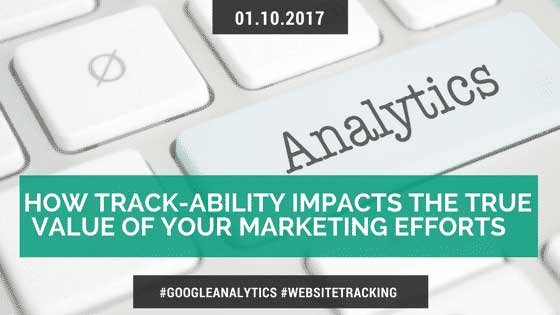Have you ever wondered how traffic started to appear magically on your website? As much as we all would love to be able to make this happen with a flick of the wrist and a wave of the wand, in all reality, there are many variables involved in bringing this to fruition.
As an agency, one of the most difficult struggles we can have is being able to quantify the value of work we do. The actual impact it has on a client, and how the changes we’ve made have an indirect impact on customers getting in contact with them.
One of the greatest tools introduced to marketers and advertisers is Google Analytics. This tool gives not only real-time stats on visitors and their behaviors on a website, but also gives us valuable insights into how the customer found the website, how long they stayed on each page, and what drove them to make a sale or get in contact with someone.
And it’s free – it’s as simple as signing up for a Google account and implementing the code across every page on your website to get started. The depths of this tool are endless, and the decision-making abilities it gives us are profound.
Now there are numerous other third party tools out there which allow users to track website data and usage, but there is still an underlying burning question which arises and stems from clients which simply put is, “How do WE know that the work YOU did was the reason we achieved these results?”
If a question could depict a million possible answers, this would be one of them, as without statistical data and proof all we have is our word and trust to be able to convince someone that what we did drove those results successfully.
In mathematics to fully answer a question, you must show a formula which indicates which steps were taken to produce the final answer. Without showing an audit trail of your work, some may question how you obtained the answer and may discredit you.
The same theory applies to marketing, if we can’t show the evidence that the marketing strategy implemented was the reason that is generating traffic and leads, then the automatic assumption is that this all happened naturally and organically.
Now stop and think to yourself, is there a viable solution to circumvent this conversation or will this dreaded question inevitably arise again?
As an agency, we have come up with a solution. It’s not 100% fool proof as nothing in life is purely perfect, but we have compiled three key steps that can be taken to increase the level of assurance and ability to track through reporting and other tools to help provide evidence. These steps can be implemented in any which order and are as follows:
- Direct Website Reporting
If you can’t count from within, then good luck accurately trying to count using others! All sites can run a server log to see what’s going on with their website. Depending on your technical background you can gain great insights from this data. However, being able to read and digest it all without knowing that to look for can make it very challenging.
Ensuring that you can track behavior on your site using plug-ins, hosting, and/or built-in theme features is crucial as this is counting from within your own directly so you have a base template of how your statistical data should appear.
Once you believe your website is tracking data accurately and correctly, the next step is to put it to the test! When they design race cars, they test them at the tracks first to ensure they handle well and can run smoothly within the terrains and environment before pushing them out on the main race track with all their competitors.
After the internal testing is complete and once you can confidently move forward with your stats, the next step is to begin adding additional reporting tools or software to your website to begin corroborating data. These will not only help with verifying your internal reporting but will also add additional insights and details which can be strategically implemented moving forward.
- Google Analytics
For some reason, this name sounds very familiar, and I can’t quite put my finger on it as to why? If this feels like déjà vu, it’s because we touched upon this earlier and are revisiting it again now because of how much value and knowledge this tool can provide you.
From demographics to time of day & device preference, Google Analytics goes above and beyond making data obtained from your website very readable and understandable. You don’t have to be a geek, nerd, or techie to understand it, and much of it can be explained and reiterated in a manner that can be quite enjoyable!
From its simplicity to obtain and ease of implementation to its robust data comprehension you can easily lose yourself for hours within the pits of data and information. There are a plethora of valuable details that can be analyzed, assessed and used towards making high-level executive decisions and optimization changes to help boost and grow Return on Investment (ROI).
Have you ever heard of Forecasting? If you’re thinking to yourself, “Is this a reference to weather?” You are correct! Well except for the fact that this reference has to do with whether or not you have clients who run promotions or sales during certain times of the year. Analytics gives you the ability to use historical data from the past along with predictable data from the future to make the best-educated decisions to have the biggest positive impact during busy seasons and especially during special holidays.
- Customer Feedback & Communication
Unless you’re heavily involved in the industry of online marketing when someone asks you “where” or “how” you found something online, the automatic human nature is to reply with “Googled it!”
Unfortunately, this same answer can’t be used as an agency when communicating with clients as it only brushes the surface of where the search journey began. It doesn’t go into the intricate complexities involved in how a strategic path was paved specifically for this journey.
The customer has visited your website or stepped foot in your store, so they’ve arrived at the final destination, and we’ve accomplished getting to the final answer. Now poses the question of how the journey began, what questions asked along the way, and what additional research or corroboration was done before making the final decision.
As an agency, we push our clients to gauge and interact with their customers beyond the sale as this not only forms a much stronger and healthier long term relationship but also helps in gathering invaluable insights.
Consider the customer journey as a massive jigsaw puzzle with each piece being an action or interaction along the way. These pieces are intertwined within each other and having a strong level of communication allows clients to fill in the blanks and understand the true meaning of the search funnel.
Following these three steps builds a strong foundation, and with a well thought out strategy and structure can be a useful blueprint for success. As an agency, it’s our job to help clients understand how to measure success, and a large part of this comes from relying on accurate data and statistics.
There are tons of other steps that can be taken to educate clients all of which can be highly effective. We have found that customers are a lot more willing to expand their marketing ventures when we can prove the impact and level of effectiveness of the work we do. Confidence and reassurance go a long way as these are pillars towards building trust, customer retention, and increased levels of investment commitment.
Take the initiative the next time you talk to a client to express how truly valuable you are and that your efforts are a key asset towards their success. Don’t allow others to take credit for the hard work and dedication you’ve put towards helping them grow and flourish.
Do your due diligence and use reporting tools to backup your strategies to prove to Clients that the notion of magic or natural causes being the reason for their successes is an incorrect assessment and that there is a much larger picture to understand.
Like any fine-tuned vehicle or machine, there are certain factors which are implemented to make things run smoothly, and the same goes with Marketing. As the landscape grows and changes as will the strategies implemented and having the necessary track-ability means in place will allow clients to visualize using graphs, charts, and reporting that every cause and effect has a root source and path of travel.











